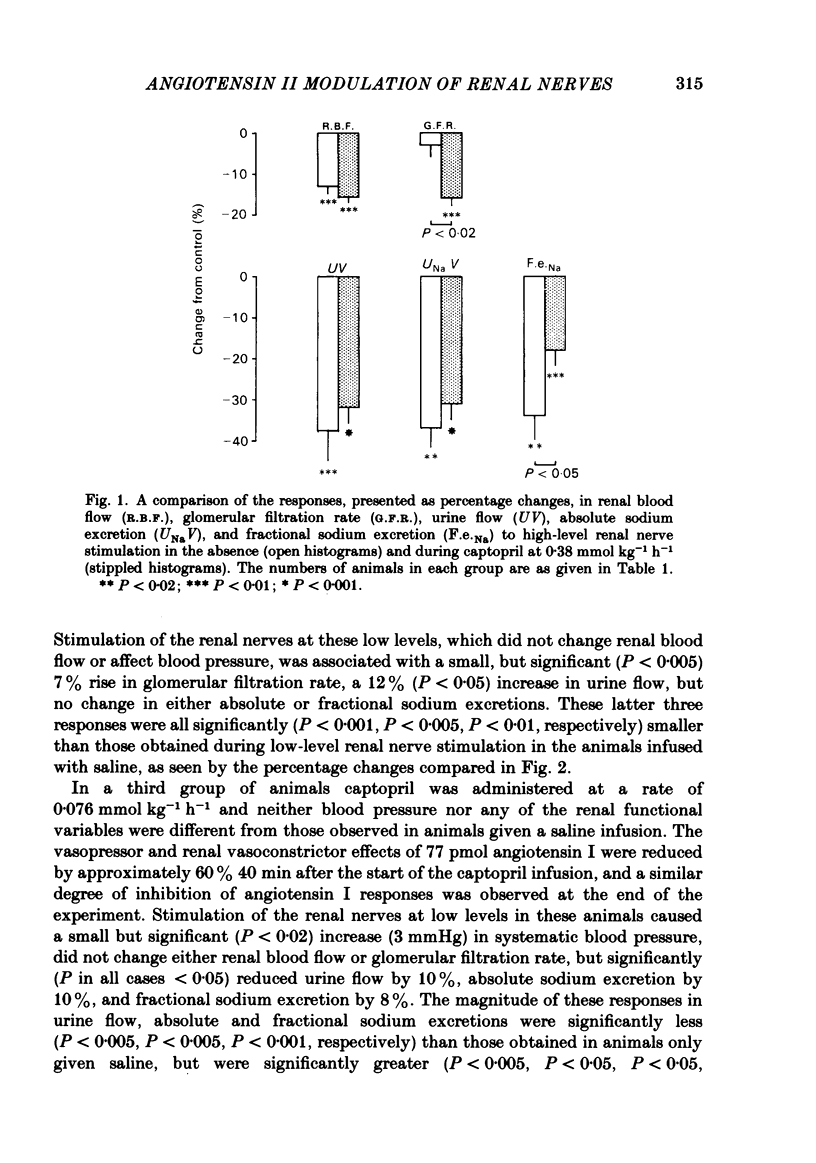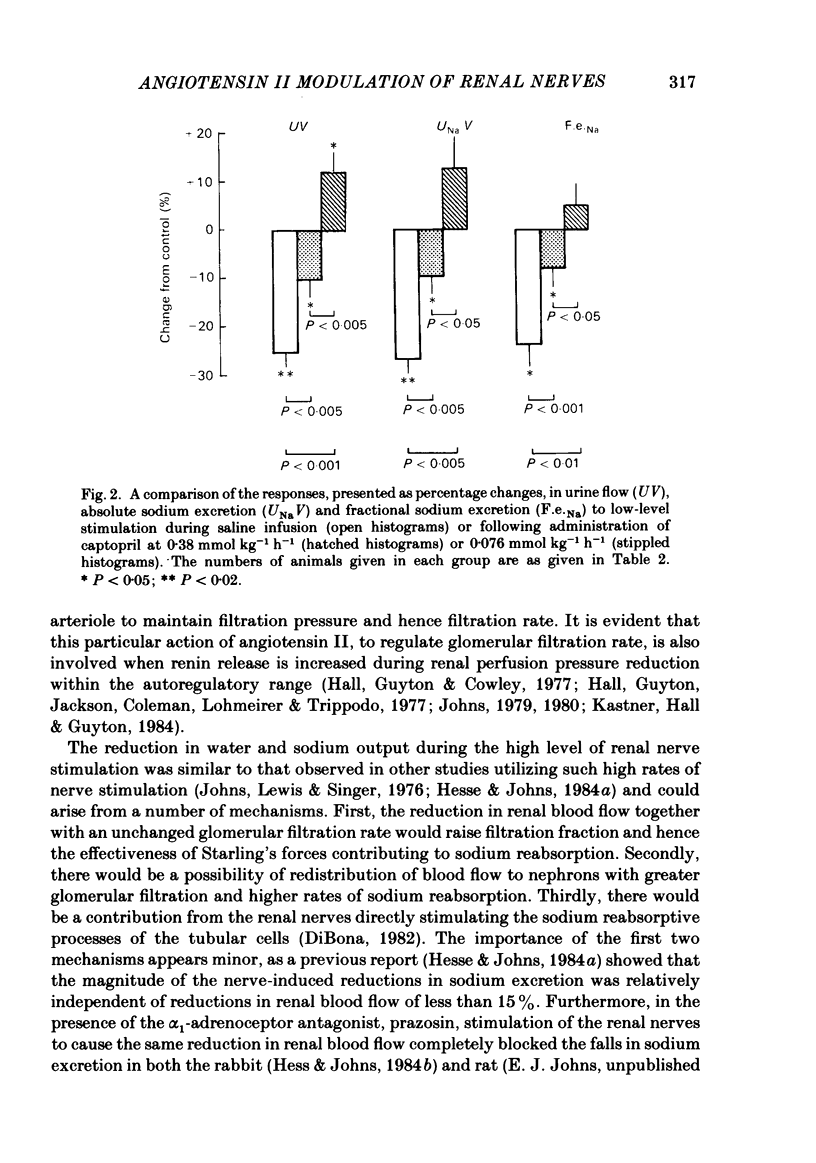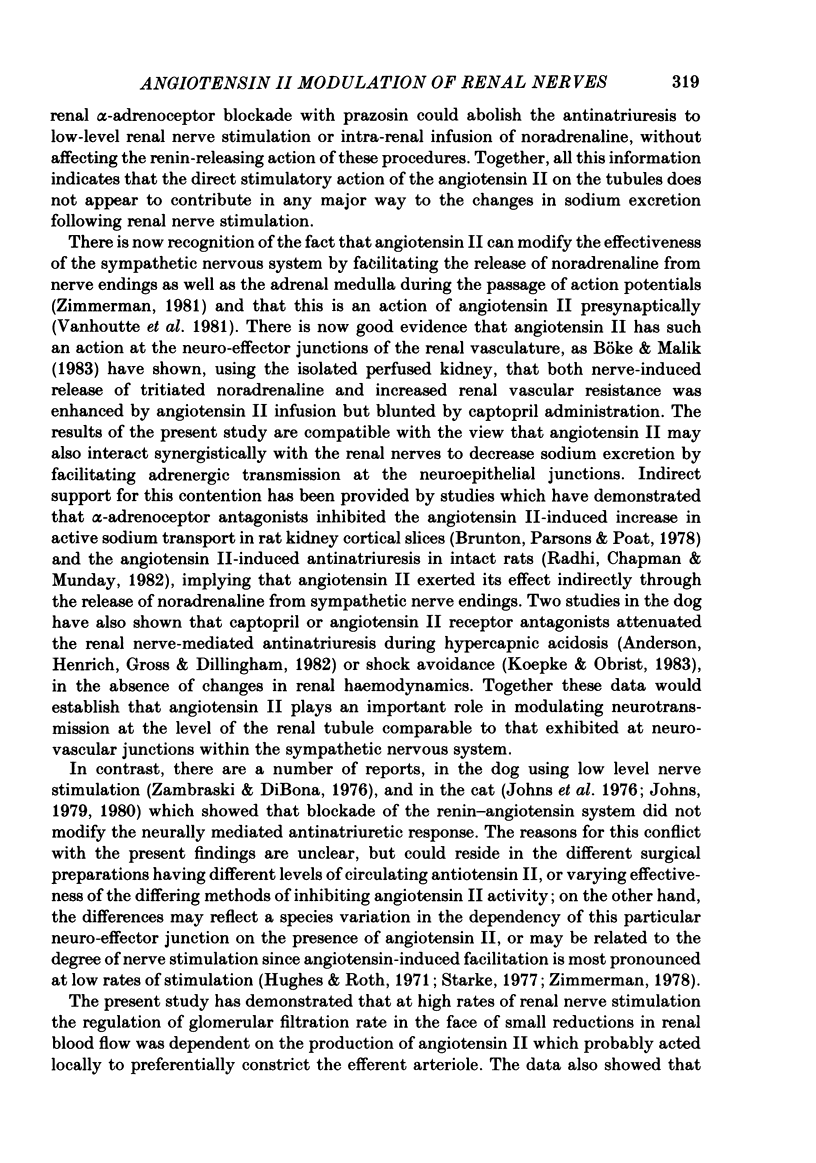Abstract
Stimulation of the renal sympathetic nerves in pentobarbitone anaesthetized rats achieved a 13% reduction in renal blood flow, did not change glomerular filtration rate, but reduced urine flow by 37%, absolute sodium excretion by 37%, and fractional sodium excretion by 34%. Following inhibition of converting enzyme with captopril (0.38 mmol kg-1 h-1), similar nerve stimulation reduced both renal blood flow and glomerular filtration rate by 16%, and although urine flow and absolute sodium excretion fell by 32 and 31%, respectively, the 18% fall in fractional sodium excretion was significantly less than that observed in the absence of captopril. Renal nerve stimulation at low levels, which did not change either renal blood flow or glomerular filtration rate, reduced urine flow, and absolute and fractional sodium excretions by 25, 26 and 23%, respectively. In animals receiving captopril at 0.38 mmol kg-1 h-1, low-level nerve stimulation caused small increases in glomerular filtration rate of 7% and urine flow of 12%, but did not change either absolute or fractional sodium excretions. At one-fifth the dose of captopril (0.076 mmol kg-1 h-1), low-level nerve stimulation did not change renal haemodynamics but decreased urine flow, and absolute and fractional sodium excretions by 10, 10 and 8%, respectively. These results showed that angiotensin II production was necessary for regulation of glomerular filtration rate in the face of modest neurally induced reductions in renal blood flow and was compatible with an intra-renal site of action of angiotensin II preferentially at the efferent arteriole. They also demonstrated that in the rat the action of the renal nerves to decrease sodium excretion was dependent on angiotensin II.
Full text
PDF










Selected References
These references are in PubMed. This may not be the complete list of references from this article.
- Anderson R. J., Henrich W. L., Gross P. A., Dillingham M. A. Role of renal nerves, angiotensin II, and prostaglandins in the antinatriuretic response to acute hypercapnic acidosis in the dog. Circ Res. 1982 Feb;50(2):294–300. doi: 10.1161/01.res.50.2.294. [DOI] [PubMed] [Google Scholar]
- Arendshorst W. J., Finn W. F. Renal hemodynamics in the rat before and during inhibition of angiotensin II. Am J Physiol. 1977 Oct;233(4):F290–F297. doi: 10.1152/ajprenal.1977.233.4.F290. [DOI] [PubMed] [Google Scholar]
- Arundell L. A., Johns E. J. Effect of converting enzyme inhibition on the renal haemodynamic responses to noradrenaline infusion in the rat. Br J Pharmacol. 1982 Mar;75(3):553–558. doi: 10.1111/j.1476-5381.1982.tb09173.x. [DOI] [PMC free article] [PubMed] [Google Scholar]
- Ball S., Johns E. J. Influence of the renin-angiotensin system in the renal haemodynamic responses to modest renal nerve stimulation in the rat. J Endocrinol. 1982 Apr;93(1):65–70. doi: 10.1677/joe.0.0930065. [DOI] [PubMed] [Google Scholar]
- Barajas L., Powers K., Wang P. Innervation of the renal cortical tubules: a quantitative study. Am J Physiol. 1984 Jul;247(1 Pt 2):F50–F60. doi: 10.1152/ajprenal.1984.247.1.F50. [DOI] [PubMed] [Google Scholar]
- Bell-Reuss E., Trevino D. L., Gottschalk C. W. Effect of renal sympathetic nerve stimulation on proximal water and sodium reabsorption. J Clin Invest. 1976 Apr;57(4):1104–1107. doi: 10.1172/JCI108355. [DOI] [PMC free article] [PubMed] [Google Scholar]
- Brunton J., Parsons B. J., Poat J. A. Possible involvement of noradrenaline in the response of rat kidney cortex slices to angiotensin [proceedings]. J Physiol. 1978 Nov;284:73P–74P. [PubMed] [Google Scholar]
- Böke T., Malik K. U. Enhancement by locally generated angiotensin II of release of the adrenergic transmitter in the isolated rat kidney. J Pharmacol Exp Ther. 1983 Sep;226(3):900–907. [PubMed] [Google Scholar]
- DiBona G. F., Sawin L. L. Effect of renal nerve stimulation on NaCl and H2O transport in Henle's loop of the rat. Am J Physiol. 1982 Dec;243(6):F576–F580. doi: 10.1152/ajprenal.1982.243.6.F576. [DOI] [PubMed] [Google Scholar]
- Hall J. E., Guyton A. C., Cowley A. W., Jr Dissociation of renal blood flow and filtration rate autoregulation by renin depletion. Am J Physiol. 1977 Mar;232(3):F215–F221. doi: 10.1152/ajprenal.1977.232.3.F215. [DOI] [PubMed] [Google Scholar]
- Hall J. E., Guyton A. C., Jackson T. E., Coleman T. G., Lohmeier T. E., Trippodo N. C. Control of glomerular filtration rate by renin-angiotensin system. Am J Physiol. 1977 Nov;233(5):F366–F372. doi: 10.1152/ajprenal.1977.233.5.F366. [DOI] [PubMed] [Google Scholar]
- Harris P. J., Young J. A. Dose-dependent stimulation and inhibition of proximal tubular sodium reabsorption by angiotensin II in the rat kidney. Pflugers Arch. 1977 Jan 17;367(3):295–297. doi: 10.1007/BF00581370. [DOI] [PubMed] [Google Scholar]
- Hesse I. F., Johns E. J. The effect of graded renal nerve stimulation on renal function in the anaesthetized rabbit. Comp Biochem Physiol A Comp Physiol. 1984;79(3):409–414. doi: 10.1016/0300-9629(84)90536-x. [DOI] [PubMed] [Google Scholar]
- Hesse I. F., Johns E. J. The role of alpha-adrenoceptors in the regulation of renal tubular sodium reabsorption and renin secretion in the rabbit. Br J Pharmacol. 1985 Mar;84(3):715–724. doi: 10.1111/j.1476-5381.1985.tb16154.x. [DOI] [PMC free article] [PubMed] [Google Scholar]
- Hughes J., Roth R. H. Evidence that angiotensin enhances transmitter release during sympathetic nerve stimulation. Br J Pharmacol. 1971 Feb;41(2):239–255. doi: 10.1111/j.1476-5381.1971.tb08025.x. [DOI] [PMC free article] [PubMed] [Google Scholar]
- Johns E. J. A comparison of the ability of two angiotensin II receptor blocking drugs, 1-Sar; 8-Ala angiotensin II and 1-Sar, 8-Ile angiotensin II, to modify the regulation of glomerular filtration rate in the cat. Br J Pharmacol. 1980;71(2):499–506. doi: 10.1111/j.1476-5381.1980.tb10963.x. [DOI] [PMC free article] [PubMed] [Google Scholar]
- Johns E. J. Action of angiotensin I converting enzyme inhibitor on the control of renal function in the cat. Clin Sci (Lond) 1979 Apr;56(4):365–371. doi: 10.1042/cs0560365. [DOI] [PubMed] [Google Scholar]
- Johns E. J., Lewis B. A., Singer B. The sodium-retaining effect of renal nerve activity in the cat: role of angiotensin formation. Clin Sci Mol Med. 1976 Jul;51(1):93–102. doi: 10.1042/cs0510093. [DOI] [PubMed] [Google Scholar]
- Johnson M. D., Malvin R. L. Stimulation of renal sodium reabsorption by angiotensin II. Am J Physiol. 1977 Apr;232(4):F298–F306. doi: 10.1152/ajprenal.1977.232.4.F298. [DOI] [PubMed] [Google Scholar]
- Kastner P. R., Hall J. E., Guyton A. C. Control of glomerular filtration rate: role of intrarenally formed angiotensin II. Am J Physiol. 1984 Jun;246(6 Pt 2):F897–F906. doi: 10.1152/ajprenal.1984.246.6.F897. [DOI] [PubMed] [Google Scholar]
- Koepke J. P., Obrist P. A. Angiotensin II in the renal excretory response to behavioral stress in conscious dogs. Am J Physiol. 1983 Aug;245(2):R259–R264. doi: 10.1152/ajpregu.1983.245.2.R259. [DOI] [PubMed] [Google Scholar]
- Levens N. R., Peach M. J., Carey R. M. Role of the intrarenal renin-angiotensin system in the control of renal function. Circ Res. 1981 Feb;48(2):157–167. doi: 10.1161/01.res.48.2.157. [DOI] [PubMed] [Google Scholar]
- Osborn J. L., Holdaas H., Thames M. D., DiBona G. F. Renal adrenoceptor mediation of antinatriuretic and renin secretion responses to low frequency renal nerve stimulation in the dog. Circ Res. 1983 Sep;53(3):298–305. doi: 10.1161/01.res.53.3.298. [DOI] [PubMed] [Google Scholar]
- Peach M. J. Renin-angiotensin system: biochemistry and mechanisms of action. Physiol Rev. 1977 Apr;57(2):313–370. doi: 10.1152/physrev.1977.57.2.313. [DOI] [PubMed] [Google Scholar]
- Pelayo J. C., Ziegler M. G., Jose P. A., Blantz R. C. Renal denervation in the rat: analysis of glomerular and proximal tubular function. Am J Physiol. 1983 Jan;244(1):F70–F77. doi: 10.1152/ajprenal.1983.244.1.F70. [DOI] [PubMed] [Google Scholar]
- Reid I. A., Morris B. J., Ganong W. F. The renin-angiotensin system. Annu Rev Physiol. 1978;40:377–410. doi: 10.1146/annurev.ph.40.030178.002113. [DOI] [PubMed] [Google Scholar]
- Rubin B., Laffan R. J., Kotler D. G., O'Keefe E. H., Demaio D. A., Goldberg M. E. SQ 14,225 (D-3-mercapto-2-methylpropanoyl-l-proline), a novel orally active inhibitor of angiotensin I-converting enzyme. J Pharmacol Exp Ther. 1978 Feb;204(2):271–280. [PubMed] [Google Scholar]
- Starke K. Regulation of noradrenaline release by presynaptic receptor systems. Rev Physiol Biochem Pharmacol. 1977;77:1–124. doi: 10.1007/BFb0050157. [DOI] [PubMed] [Google Scholar]
- Vanhoutte P. M., Verbeuren T. J., Webb R. C. Local modulation of adrenergic neuroeffector interaction in the blood vessel well. Physiol Rev. 1981 Jan;61(1):151–247. doi: 10.1152/physrev.1981.61.1.151. [DOI] [PubMed] [Google Scholar]
- Zambraski E. J., DiBona G. F. Angiotensin II in antinatriuresis of low-level renal nerve stimulation. Am J Physiol. 1976 Oct;231(4):1105–1110. doi: 10.1152/ajplegacy.1976.231.4.1105. [DOI] [PubMed] [Google Scholar]
- Zimmerman B. G. Actions of angiotensin on adrenergic nerve endings. Fed Proc. 1978 Feb;37(2):199–202. [PubMed] [Google Scholar]
- Zimmerman B. G. Adrenergic facilitation by angiotensin: does it serve a physiological function? Clin Sci (Lond) 1981 Apr;60(4):343–348. doi: 10.1042/cs0600343. [DOI] [PubMed] [Google Scholar]


